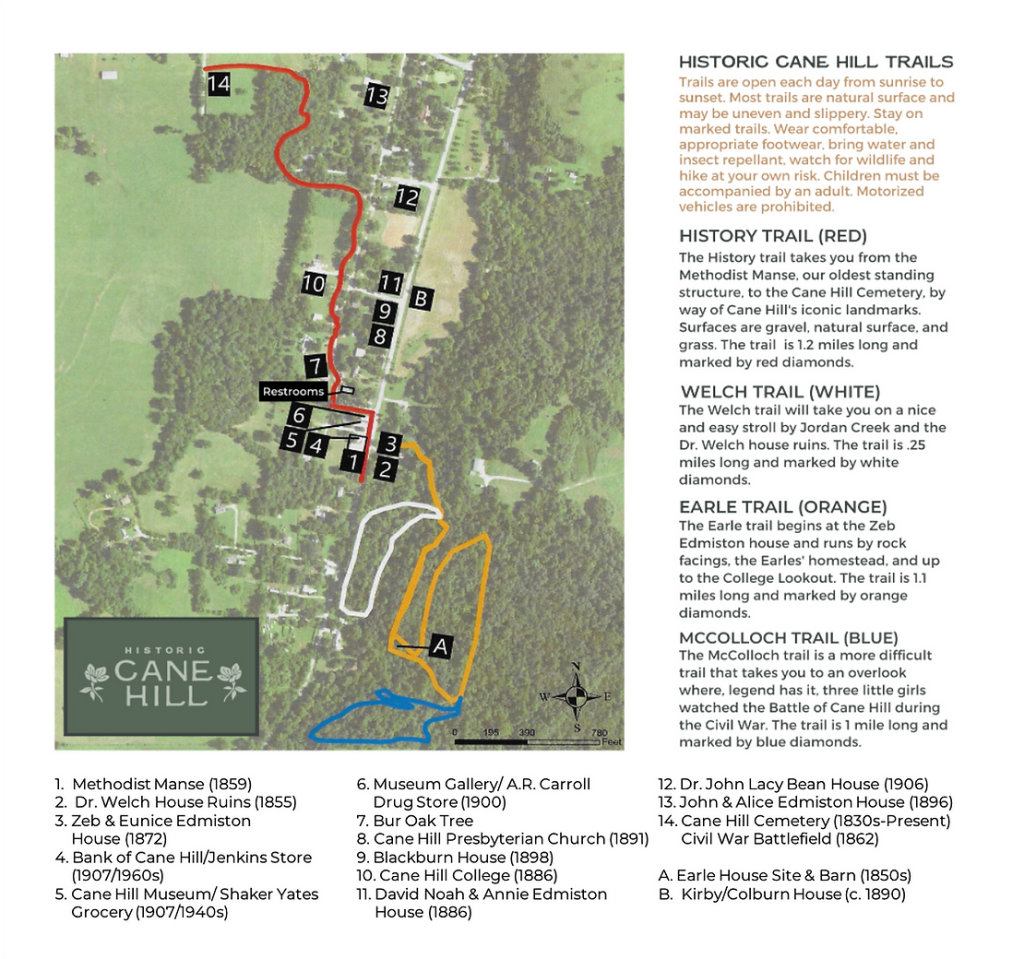Hidden in the Ozarks, you’ll find a tiny little town seemingly untouched by time. This Civil-War-Era historical gem features a museum, hiking trails, traces of the Trail of Tears, and a handful of well-preserved historical structures. Visit Cane Hill, Arkansas for a delightful step back into time.

Heads up: This page contains Amazon affiliate links. That means if you click and buy—we may receive a small commission at no additional cost to you. Read more about it here.
In this article: Buildings | Trail of Tears | Museum | Hiking Trails | Cabin
The best time to visit is the 3rd weekend in September. The community of Cane Hill hosts an annual festival filled with makers and artisans that come together to celebrate history and the Ozarks way of life.
First, let’s settle a quick debate…is it Canehill, Arkansas or Cane Hill, Arkansas? That’s a valid question. Officially, it depends on who you ask. There was a vote that officially chose a spelling, but it didn’t quite stick! The truth is, this unincorporated community or census-designated place isn’t even quite a small town. That hasn’t always been the case.
In the mid-1800s, it was a growing coal mining city. But as with many dying early settler towns, the railroad drew business away and the population dwindled. Still, over the centuries, the name of this rural community has changed more than a few times. It’s been known as Canehill, Cane Hill, Boonsboro, Boonsborough, and Coal City.

How small is it? In 2020, there was a population of 74. With such a small size, it’s impressive that Canehill also lists 17 entries on the national register of historic places. This makes it worth a visit.
When you visit the community of Cane Hill, Arkansas, I recommend packing a picnic basket (because there’s literally zero options for lunch) and planning to spend a couple hours exploring the history of Canehill located six miles Southwest of Fayetteville, Arkansas on route 45.
Historic Sites in Canehill, Arkansas
While most towns have had nearly every bit of history erased by industrialization and technological advancement, this little mountain town remains virtually untouched by time. You can still visit the Cane Hill cemetery with gravesites dating back to 1830, you’ll find several well-preserved tombstones of the area’s original founders as well as Civil War soldiers.

Another notable claim to fame for Canehill is Cane Hill School (or later named Cane Hill College) which was founded in 1834 as the first recognized school in Northwest Arkansas. The building still stands in well-preserved condition today.
Here is a complete list of historical structures you can visit:
- Cane Hill College
- Cane Hill Cemetery
- Greek Revival-Style Earle House Ruins
- R.L. Leach Store (Grocery & Post Office)
- Bank of Canehill /Jenkins Store
- John Lacy Bean House
- A.R. Carroll Drug Store
- John and Alice Edmiston House
- Cane Hill Presbyterian Church
- David Noah Edmiston House
- Methodist Manse
- Zeb Edmiston House
- McCarty House
Trail of Tears in Historic Canehill, Arkansas
Cane Hill is believed to be the last stop in the B.B. Canon contingent before the group entered Indian territory (present-day Oklahoma). There is a journal entry that mentions Cane Hill with reference to a giant Bur Oak tree that still stands today where three young children who died on the trip were buried.
Read More: Explore Native American History and Culture in the Ozarks
Cane Hill Museum
We’re not big museum people, but we fell in love with the little museum in Cane Hill which features period-appropriate exhibits on the American Civil War Battle in Cane Hill, life in early Cane Hill, Boonsboro pottery, and Ozark Folk Art.
The museum is open for self-guided tours Thursday-Saturday from 10am-2pm. There is also a collection of genealogical materials available for public research. If you’re from Arkansas, stop by and see if you can fill in some spots on your family tree.
Hiking Trails in Canehill, Arkansas
There are four short, well-kept hiking trails in Cane Hill. From self-guided history walking tours to a serene stroll along the creek and around a hill, this little town is perfect for getting your steps in. Plus, there is a community pavilion to provide a comfortable spot for your picnic lunch.

Heritage Trail: A 1.2-mile mixed surface trail that goes by several historic sites on its way up the hill to the Cane Hill Cemetery.
Jordan Trail: An easy 0.25-mile stroll by Jordan Creek with a view of the Dr. Welch home ruins.
Earle Trail: A 1.1-mile hike up a hill, around limestone rocks, past the Earle homestead, and up to College lookout.
McCollough Trail: A steeper, 1-mile hike up to a lookout where it is said that 3 young girls watched the Civil War Battle of Cane Hill.
All 4 trails can be combined for a longer hike.

Explore the Civil-War Era History in the Ozarks with A Trip to Historic Cane Hill, Arkansas
The Ozarks are full of small mountaintop towns filled with their own variety of culture and history and Cane Hill is no exception. Make this little town a stop for an afternoon in Northwest Arkansas.
Check into this nearby cabin for your visit to Canehill, AR which has a hot tub and sleeps 7.

Also check out nearby attractions like Fayetteville, Arkansas, the Siloam Springs Kayak Park, and Devil’s Den State Park in West Fork.